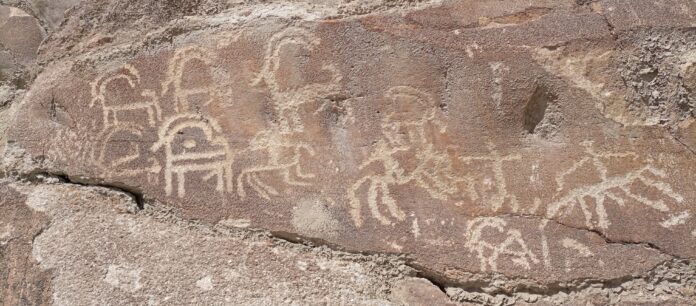The Sacred Rock of Hunza, also known as Haldeikish, is one of the most significant cultural heritage sites in the Gilgit-Baltistan region of northern Pakistan. Situated along the ancient Silk Route, this site is renowned for its intricate petroglyphs (rock carvings) that date back to the 1st Millennium AD. These carvings provide a fascinating glimpse into the region’s rich history, cultural exchanges, and the diverse civilizations that once thrived in this area.
Location and Accessibility
The Sacred Rock is located on a hilltop to the east of the Hunza River, near the town of Karimabad in the Hunza Valley. It lies along the Karakoram Highway (KKH), which connects Pakistan to China, making it easily accessible to travelers. The site is just a five-minute drive from the UNESCO-listed village of Ganish and is positioned between Ganish and the stunning Attabad Lake.
The rock itself is approximately 180 meters in length and 9 meters at its highest point, consisting of four main boulders. It is divided into two portions: an upper section with inscriptions and a lower section adorned with carvings of animals and deities.
Historical Significance
The Sacred Rock of Hunza is a treasure trove of ancient art and inscriptions, reflecting the cultural and historical exchanges that took place along the Silk Route. The carvings and inscriptions are written in various scripts, including Bactrian, Sogdian, Kharoshti, Tibetan, Chinese, and Brahmi, showcasing the diversity of travelers and traders who passed through the region.
Upper Portion: Inscriptions
The upper portion of the rock features inscriptions in ancient scripts such as Sogdian, Kharosthi, Brahmi, Sarada, and Proto-Sarada. These inscriptions mention the names of prominent historical figures, including Emperor Kanishka and Huvishka of the Kushan Empire, as well as Ramadusa, a king of the Trukha Kingdom. The presence of these names highlights the region’s importance as a crossroads of empires and cultures.
One of the most notable inscriptions references Chandragupta II of the Gupta Empire, with the text reading, “Chandra Sri Vikramaditya conquers”, dated to around 419 AD. While some scholars identify “Chandra” as Chandragupta II, others suggest it could refer to a local ruler, leaving room for further historical exploration.
Lower Portion: Petroglyphs
The lower portion of the rock is adorned with carvings of ibexes, which were culturally significant to the region’s ancient inhabitants. These carvings depict ibexes in various scenes, including hunting and interaction with horned human deities. The ibex, a symbol of strength and agility, holds a special place in the cultural and spiritual traditions of the region.
Additionally, the carvings include depictions of a Tibetan-style stupa and an image of an ancient Chinese king, further emphasizing the cultural diversity of the Silk Route.
Haldeikish: The Name and Its Meaning
The name Haldeikish translates to “a place of many male ibexes”, reflecting the abundance of ibexes in the area during ancient times. The numerous ibex carvings on the rock serve as a testament to the region’s natural heritage and the importance of this animal in the lives of the people who once inhabited the area.
Preservation and Challenges
The Sacred Rock of Hunza is a Cultural Heritage Site of Pakistan and is currently under the protection of the Commissioner of Northern Areas and the Director of Archaeology. While efforts have been made to preserve the site, the harsh weather conditions and natural erosion in the mountainous region have taken a toll on the rock carvings and inscriptions. Many of the Buddhist shelter caves that once surrounded the site have collapsed over time, with only a few remaining intact.
Recent flooding in the Hunza River has also posed a threat to the site, raising concerns about its long-term preservation. Continued efforts are needed to protect this invaluable piece of history for future generations.
Tourist Attraction
The Sacred Rock of Hunza is one of the major tourist attractions in Gilgit-Baltistan, drawing visitors from around the world who are eager to witness its ancient carvings and inscriptions. Its location along the Karakoram Highway makes it a convenient stop for travelers exploring the region’s natural beauty and cultural heritage.
The Sacred Rock of Hunza stands as a timeless testament to the rich history and cultural diversity of the Hunza Valley and the broader Silk Route. Its petroglyphs and inscriptions offer a window into the lives, beliefs, and interactions of the people who once traversed this ancient trade route. As a cultural heritage site, it not only preserves the past but also serves as a symbol of the enduring legacy of human creativity and resilience in the face of time and nature.
References
- HALDEIKISH, Sacred Rocks of Hunza.” Hunza Bytes. Retrieved 2022-05-20.
- Department of Archaeology and Museums
- UNESDoc (UNESCO).” Unesdoc.unesco.org. Retrieved 2014-07-05.
- Sacred Rocks at Hunza – Ganish, Pakistan.” Lonely Planet. Retrieved 13 February 2019.
- R. C. Majumdar (1981). A Comprehensive History of India. Vol. 3, Part I: A.D. 300-985. Indian History Congress / People’s Publishing House.
- Upinder Singh (2008). A History of Ancient and Early Medieval India: From the Stone Age to the 12th Century. Pearson Education India.

